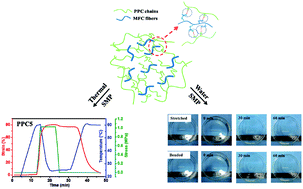Microfibrillated cellulose reinforced bio-based poly(propylene carbonate) with dual-responsive shape memory properties
Abstract
A novel biodegradable polymer-based composite with excellent dual-responsive shape memory properties based on poly(propylene carbonate) (PPC)/microfibrillated cellulose (MFC) was prepared. MFC was modified by a one-step mechanical–chemical approach involving ball milling and an esterification reaction to improve its dispersion. The shape memory properties of PPC/MFC-BR composites and PPC/unmodified MFC composites were compared, and the former showed better shape memory properties due to the uniform dispersion of MFC-BR which ensured a higher fraction of the interfacial zone than unmodified MFC. Here, MFC-BR fibers act as multifunctional cross-links, reinforcing fillers, and relaxation retarders. In addition, the composites with a MFC-BR content of 5–10 wt% showed a good shape memory effect upon exposure to water at 30 °C due to the hydrophilicity of MFC-BR. The mechanism was mainly ascribed to water molecules destroying the hydrogen bonding at the polymer–filler interfaces, which reduced the glass transition temperature and increased the flexibility of the polymer chains. Our work provides a composite approach to tune the shape memory behavior of polymer composites and may contribute to the application of PPC in the smart materials field.


 Please wait while we load your content...
Please wait while we load your content...